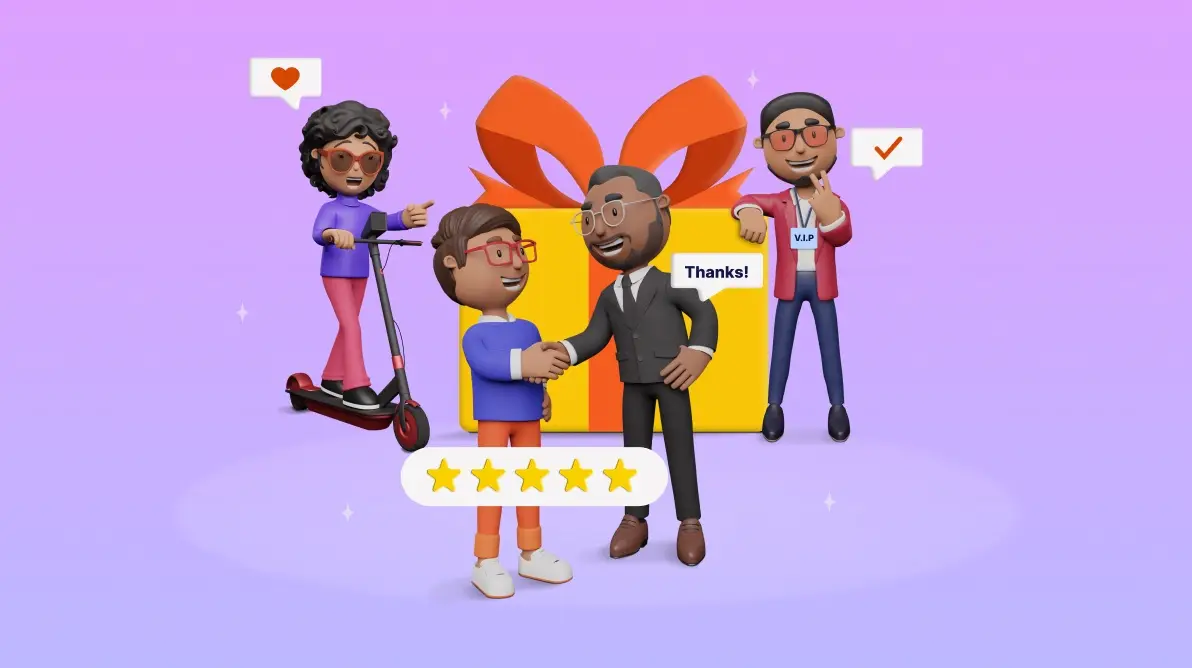Expecting every initial customer to stay loyal for years is unrealistic, as some level of customer turnover is inevitable. Therefore, maintaining your customer loyalty level is crucial. But how can you maintain customer loyalty?
The secret lies in consistently trying to understand your customers and their needs, engaging them with your product, and ensuring their satisfaction to retain their support.
Statistics by Microsoft prove this by stating that 96% of customers choose to stay loyal to brands that offer exceptional customer service.
In the event that you want to foster customer loyalty, the pivotal question still stands: Can you cultivate customer loyalty? If your answer is no, then don’t panic. We’ve got you.
In this article, we will give you detailed guidelines on customer loyalty, its importance, strategies, and how to measure customer loyalty.
What is customer loyalty?
Customer loyalty is a measure of a clients’ likelihood to repeat business with a company.
It shows the level of commitment your customers have for your products. This could result from consistent customer satisfaction, positive customer experience, and good overall customer service or values.
How can you identify loyal customers?
Loyal customers can be identified by looking at:
- Clients who regularly purchase your products or services.
- Customers who offer suggestions on how you can enhance your customer service.
- Customers who often provide feedback.
- Customers who promote your brand by recommending your products and services to family and friends.
- Customers who often interact with your brand across multiple platforms.
Types of loyal customers
In every business, there are different types of customers. However, what’s essentially needed for a business to blossom is loyal customers since they are crucial for a company’s profit margin.
According to Small Business Trends, 65% of any company’s business is from existing customers.
But wait, who are these existing customers? Definitely, loyal customers.
Loyal customers are categorized into two different loyalties, namely:
Behavioral loyalty
Behavioral loyalty on the other hand is when customers repeatedly purchase from a brand out of routine, benefits, or convenience.
The most common types of behavioral loyalties are:
- Loyalty program customers: These are customers who are influenced by reward programs offered by businesses. They exhibit loyalty by frequently purchasing from the same company to earn points, discounts, or other benefits.
- Benefits customers: The benefits or value derived from a product or service drive these customers. They are not only price-oriented, but also consider other aspects, such as quality, brand reputation, and associated services.
- “Got no option” customers: These are customers who do business with a company because they have no other alternatives. This could be due to a monopoly, geographical constraints, or specific needs only one business can fulfil.
- Convenience customers: These are customers who prioritize convenience over other factors such as price or brand. They are likely to buy from businesses that offer easy access, quick service, home deliveries, or online shopping options.
- Loyal to price customers: These customers prioritize price above all else. They are loyal to the company or brand that offers the most competitive or lowest prices and will switch to another brand if it offers a better deal.
Attitudinal loyalty
This occurs when customers are emotionally attached to a company’s product or service. These customers not only repeatedly purchase but are also likely to recommend the brand to others.
The most common types of attitudinal loyalties are:
- Satisfied customers: These are customers who have had a positive customer service experience or have had their expectations met or exceeded by a product or service.
- Truly loyal customers: These are customers whose loyalty is based on a deep-rooted preference due to consistent satisfaction, emotional connection, or habit. They will consistently choose the same company or brand irrespective of price or other benefits.
Why is customer loyalty important?
Customer loyalty is not simply a minor factor, but a significant cornerstone in the development of a company. Here are some of the benefits customer loyalty offers.
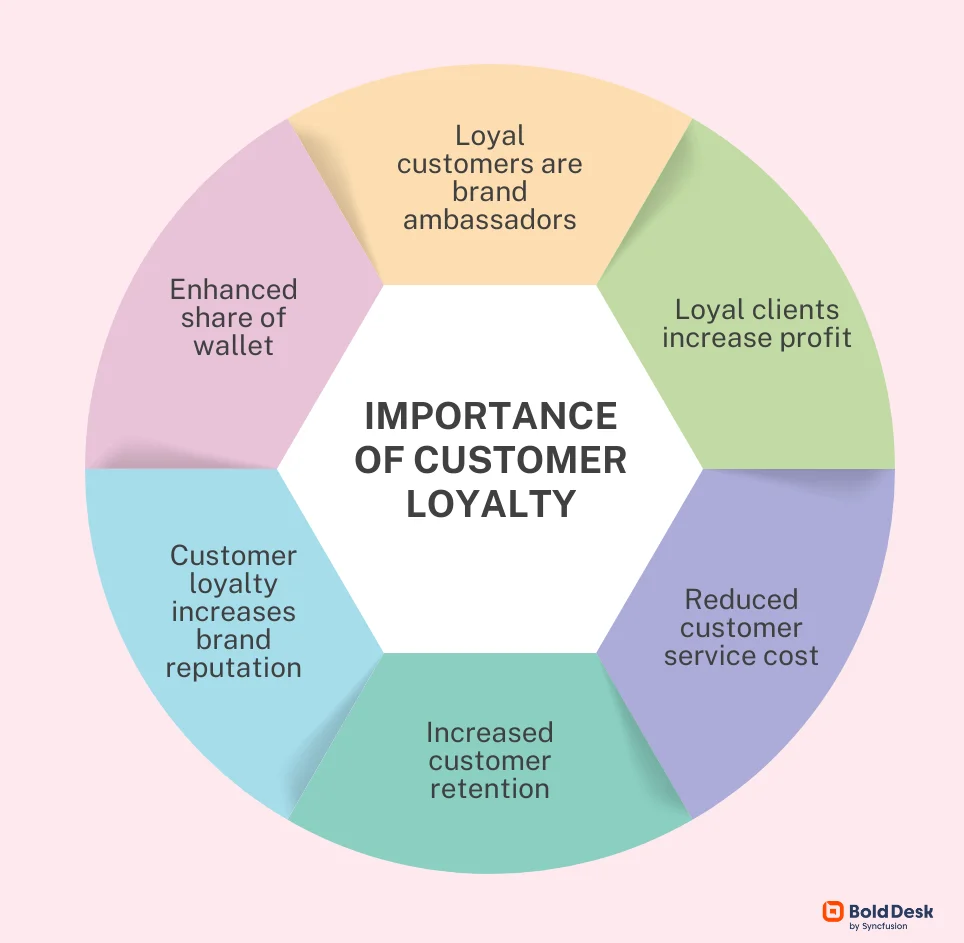
Loyal customers are brand ambassadors
Loyal customers not only provide steady income, but they often recommend the brand to others, serving as brand ambassadors.
They share their positive experiences and promote the brand within their social circles, influencing others to try the products or services.
As a result, word-of-mouth marketing becomes incredibly valuable as it helps in attracting new customers.
Loyal clients increase profit
Loyal customers are more likely to purchase products repeatedly or often spend more on a product than new customers.
Consequently, consistent and increased spending on the same company’s products results in higher profit levels for the business.
In line with this, 43% of consumers spend more on companies and brands to which they are loyal.
Regular and repeat product purchases increase a company’s overall sales, thus increasing the profit margins of the company.
Reduced customer service cost
It is generally more costly for a brand to acquire first-time customers than to retain existing ones. This is because customers already familiar with a company’s products or services are less likely to require customer service assistance.
Customer loyalty reduces the cost associated with onboarding new customers, thus reducing a company’s onboarding costs.
Increased customer retention
Customer loyalty directly influences customer retention.
According to statistics, 82% of firms agree that customer retention is more cost-effective than acquisition.
When customers are loyal to a brand, they stay with it for a longer period, leading to increased customer retention.
Certainly, a higher retention rate increases the customer lifetime value in a company, thus increasing the company’s profit margin.
Customer loyalty increases brand reputation
Loyal customers, due to their positive experiences with a brand, are more likely to leave positive reviews on social media platforms or even on the company’s website.
Affirming this, Statista states that 41% of customers would leave a positive review when their customer experience expectations are met or exceeded.
These reviews can boost a company’s reputation, which aids in attracting new customers.
Enhanced share of wallet
Wallet share refers to the proportion of a customer’s total spending that is allocated to a specific company in comparison to what is spent on that company’s competitors.
Customers who are loyal to a company will typically spend more time and money. This leads to an increased wallet share for your company.
Customer loyalty strategies to implement
To have an improving business, you need to have a good count of customers who are loyal. Here’s what to do to win clients over and increase your customers’ loyalty.
Offer exceptional customer service
Make your customers’ loyal by providing better customer service experience, easing how your customers can reach out and get the help they need at the appropriate time.
To achieve this:
- Provide omnichannel support to ensure a seamless experience across multiple channels, such as email, live chat, phone, and social media.
- Offer multilingual customer service.
- Provide a knowledge base.
- Integrate your customer service with AI.
- Implement an SLA in your customer service.
- Provide integrated ticketing software.
- Reduce your customers’ wait time and resolve their issues effectively.
Engage customers
Engage your customers by creating meaningful interactions and building relationships that keep them interested in your product or service.
You can achieve this by providing relevant content, interactive experiences, or personalized offers.
You can also utilize the best customer engagement strategies for better results. Moreover, you need to have a vast number of communication channels such as:
- Social media
- Live chat
- Official email
- Websites and webforms
- Community forums and self-service portals
Personalize customer interaction
Personalize your customer interaction by tailoring your communication using clear, concise, and consistent language.
You can also meet individual customer needs and preferences by applying empathetic language and implementing proactive communication.
Additionally, show your customers that you understand and value them as individuals.
To achieve this, send personalized emails, product recommendations, and offers based on past customer behavior or preferences.
Implement the best customer loyalty programs with different coupons
To engage your customers, you ought to implement coupons. You can do this by using various strategies to incentivize customer behavior.
The advantage coupons offer is that they encourage purchases, reward customer loyalty, or reactivate lapsed customers.
Offering different loyalty programs may target different customer segments and serve different business goals, such as increasing sales, boosting customer retention, or promoting certain products and services.
Make continuous improvements in your business
In a competitive business environment, customer loyalty is one of the backbones of the sustainability of a business and for its growth.
Another strategy to improve customer loyalty is the continuous advancement of your operations, services, and products.
To achieve this, you can analyze your customers’ reviews and work toward improving their concerns by introducing new features in your help desk.
This approach ensures the delivery of quality products and services that meet or exceed customer expectations, thereby enhancing their satisfaction and loyalty.
How do you measure customer loyalty?
To know your customer’s loyalty, you need to measure it. There are different types of metrics used to measure customer loyalty. Each metric assesses a unique aspect of a customer’s degree of loyalty.
Here are some metrics you can use:
Customer retention rate (CRR)
Customer retention rate is a metric used to determine the percentage of customers a company has been able to retain over a certain period of time. It provides insights into the effectiveness of customer loyalty and satisfaction initiatives.
A high CRR indicates customer satisfaction, while a low rate could signal potential issues with a product or service.
Use the following formula to calculate it:

Customer lifetime value (CLV)
Customer lifetime value is a metric used to predict the total value a business can derive from its entire relationship with a customer. It can help in tracking total revenue a business can make from a customer over the whole period of relationship.
Moreover, CLV helps businesses determine how much they should spend on customer acquisition and retention.
To calculate CLV, use the following formula:

Net promoter score (NPS)
Net promoter score is a measure of customer loyalty and satisfaction. It gauges a customer’s willingness to recommend a company’s products or services to others.
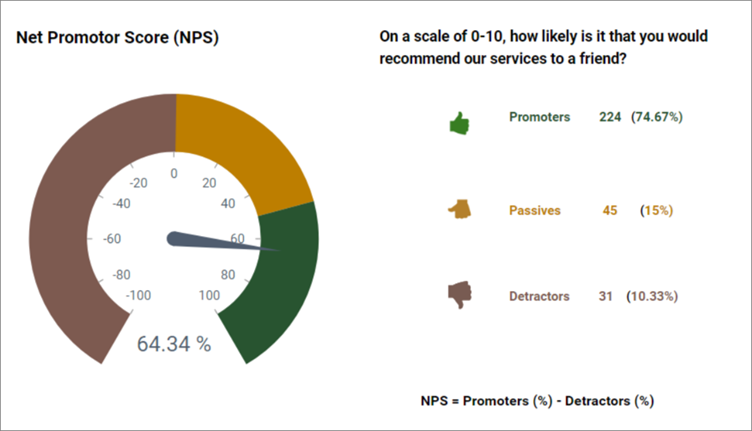
NPS is rated between 0 and 10, with detractors gauging 0-6 and promoters gauging 9-10.
To calculate NPS, use the following formula:

Where:
% of Promoters = (Number of promoters (customers who rate 9 or 10)) / (Number of respondents) * 100
% of Detractors = (Number of detractors (customers who rate 6 or less)) / (Number of respondents) * 100
Although the formula is simple, sorting through survey data can be time-consuming and repetitive, especially for support teams. The BoldDesk NPS calculator offers a faster, more intuitive way to assess customer loyalty and sentiment.
Customer satisfaction score (CSAT)
Customer satisfaction score is a metric that measures how happy customers are with a company’s products, services, and capabilities.
CSAT is generally measured using surveys that ask customers to rate their satisfaction on a scale of 1 to 5. Where 1 indicates very dissatisfied and 5 is very satisfied.
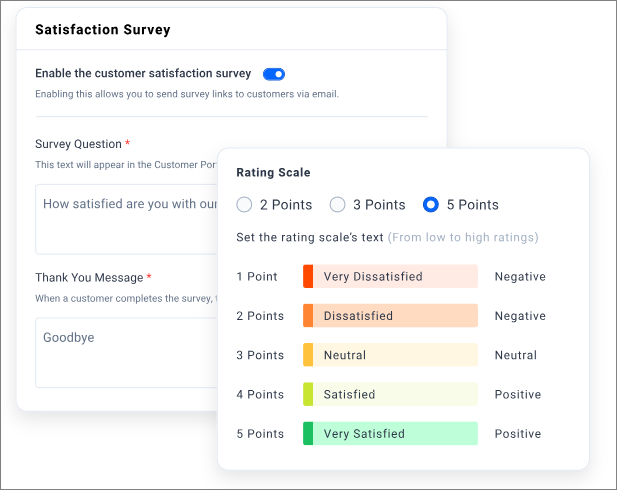
To calculate CSAT, use the following formula:

Customer effort score (CES)
Customer effort score measures the ease with which customers can get their issues resolved. By measuring CES, a company can track the difficulty its customers find in using its products or services.
Certainly, CES is particularly useful for online businesses and SaaS brands, helping to estimate churn risk and repeat purchase likelihood.
A lower score means customers can solve their problems with less effort, leading to higher satisfaction.
To calculate your CES, use the following formula:

Repeat purchase rate (RPR)
Repeat purchase rate is the percentage of customers who have purchased more than once from a company.
A high RPR indicates customer loyalty, suggesting that the product or service meets or exceeds customer expectations.
RPR can be calculated as:

Upsell ratio
Upsell ratio is a metric used to measure how willing active customers are to buy new or different products and services from you.
The upsell ratio can be a good indicator of customer loyalty.
The more diverse the additional product is from the first, the stronger the loyalty indication.
To calculate your business’ upsell ratio, use the following formula:

Customer loyalty index (CLI)
Customer loyalty index is a metric used to measure the loyalty of a company’s customers over time.
It is based on factors like customer retention, repeat purchases, and recommendations.
The most-used questions in this survey are:
- How likely are you to recommend our company or service to a friend?
- How likely are you to buy from our company again?
- How likely are you to try other company’s products or services?
To calculate your business’s CLI, use the following formula:

Customer engagement score
Customer engagement score is a composite metric that measures both active and “free trial” customers’ engagement with a brand based on product or service usage.
Each customer earns a point for every engagement they make in every customer service.
Customer engagement score is particularly useful for online businesses and SaaS brands, helping to estimate churn risk and repeat purchase likelihood.
To calculate customer engagement score, use the following formula:

Social media behavior
In comprehending customer loyalty, monitoring conduct is as vital as tracking metrics.
By regularly tracking and performing searches using keywords associated with your brand on social media, or employing social listening applications, you can understand what customers are saying about you.
This identifies both positive and negative sentiment, thus improving products and services.
What’s customer loyalty all about?
In today’s fast-paced and competitive business environment, most customers will go for the right business to fulfil their business expectations.
Therefore, it is crucial to provide exceptional customer service that leads to better customer experience, which in turn increases customer loyalty.
Nonetheless, to boost your business and increase customer loyalty, try BoldDesk®. If you aren’t quite sure of its features, schedule a live demo to see how it works. You can also start a free trial to explore its many features.
If you have any questions about the product and its functions, the BoldDesk support team is ready to assist.
Related articles
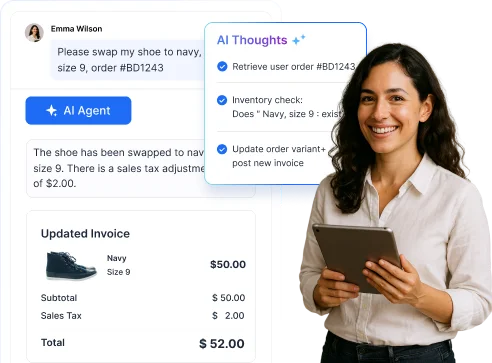


















 Email Ticketing System
Email Ticketing System Shared Inbox Software
Shared Inbox Software Multi Brand Help Desk
Multi Brand Help Desk Internal Help Desk Software
Internal Help Desk Software Trouble Ticketing Software
Trouble Ticketing Software Mobile Help Desk
Mobile Help Desk 










